Summary of findings from the New Horizons mission that passed last year near the dwarf planet Pluto - continued fromPart a'
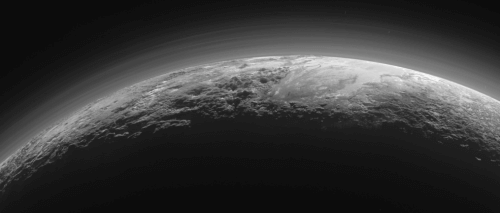
clouds
One of the surprises was that, despite the thinness of Pluto's atmosphere, it can carry clouds and these are not water clouds, but of nitrogen ice particles, methane and other components. In the atmosphere of Pluto there are layers of haze and there is a difference between clouds that are in the different layers of the haze (25). It may be that frozen nitrogen, methane, and CO vapors rise from Sputnik Planum into the atmosphere and return to the ground as rain elsewhere on Pluto (26).
Underground ocean
In 2010, it was hypothesized that Pluto probably has a rocky core containing radioactive materials which, with their gradual decay, release a substance that melts water ice and thereby creates an underground water ocean. It is estimated that radioactive potassium is found in the core, which allows for the presence of an underground ocean that is between 168-96 km thick and whose peak is 192 km below the surface (27). It is estimated that this ocean is between a layer of floating water ice and its rocky interior (28).
haze
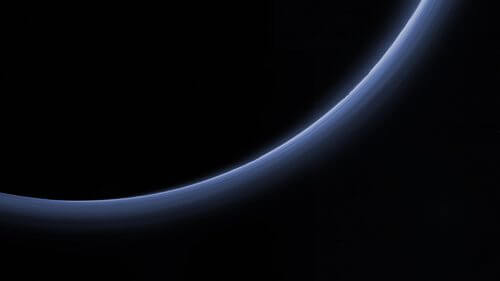
In a publication delivered on 24.7.2015/130/50, it was stated that the spacecraft discovered haze at a height of 80 km above the ground. This haze plays an important role in the formation of the hydrocarbon compounds that give the soil its red hue. They noticed two layers of haze, one at an altitude of 50 km and the other at an altitude of 29 km. The estimates that preceded this age are that Pluto is too hot to form haze at heights above 30 km (XNUMX). This haze creates a twilight effect that softly illuminates the night side of Pluto (XNUMX). It turned out that the haze has more layers than thought. The haze appears brighter in the evening than in the morning, which raises the possibility that the haze and its dispersion are created by processes that occur during the day and become concentrated during the long day of the emitter and fade during the long night as well. Most likely the haze particles reach the ground gently in the form of rain during the night and paint the ground red.
In the photographs examined, crusty tracks are seen moving along the rim of Pluto far beyond where the sunlight is supposed to touch the ground. This has characteristics of crepuscular rays - beams of sunlight that illuminate the atmosphere and break up between spaces within the topographical structures on Pluto's rim (terminator). This phenomenon indicates that the haze of Pluto is not limited only to the heights but also to the lower layers of the atmosphere. It turned out that Pluto has several layers of haze that also have periodic structural discontinuities in some of them, which raises the possibility of waves in the atmosphere (31).
The color of the haze is blue. Most probably the haze particles are gray or red but during their dispersion they get the blue color. According to the researchers' assessment, the tholin particles are formed in the upper part of the atmosphere, a place where the sun's ultraviolet radiation breaks down ionized molecules of methane and nitrogen and allows them to form chemical reactions among themselves to form more complex ions, a process first observed in the atmosphere of Saturn's moon Titan. The complex molecules continue to bond together and begin to grow or they become small particles, volatile gases condense (condese) and become covered in frost before they pass through the atmosphere and reach the ground, where they add their red color. Another finding showed small areas not covered by water ice (32). The high haze layer is found at an altitude of 200 km (33). The brightness of the haze changes depending on the illumination coming from the sun and from the observer's point of view, it can be caused by waves buoyancy. These waves are created by air flow over mountain ranges. This phenomenon is known on Earth and Mars (34).
Surface
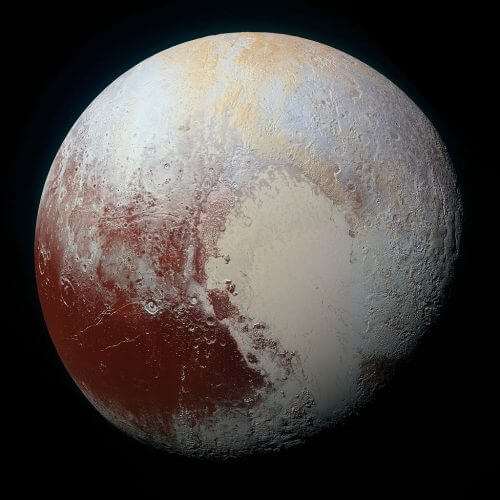
Comparing photographs taken with the Hubble Space Telescope in 1994 and those taken in 2003-2002, it was noticed that the North Pole became brighter while the South Pole became darker. These changes indicate complex processes that affect the visible light field of the ground. It was hoped that the photographs taken by the spacecraft would help in understanding these changes (35). The photographs that came from the spacecraft confirmed the strong light reflection observed in those observations (36). There is a sharp difference in brightness between the bright northern hemisphere and discontinuous strips of dark color along the equator (37). Complex polygons were found with east-northeast direction. They are 1600 km long and a dark area with light spots meets with other dark whale-like ones (38). When the spacecraft was 22.9 million km from Pluto, they noticed a bright and very large spot near the North Pole. It was not clear what its origin was. Some thought it was frozen methane or water ice. This is not the only bright spot (39).
Along the equator, 4 large spots were found, each 480 km long. They appear to be on the side facing the Charon Moon. Is there any connection between these two data or is this phenomenon also found on the other side of Pluto. These spots are associated with a dark band surrounding the equator. What is interesting is that they are of the same order of magnitude and the intervals between them are equal (40).
Already at the beginning of the filming, a land formation that looks like a heart was discovered. This formation was named the Tombaugh Regio. It is on the equator and its dimensions are 1760 - 1488 km. This is a huge area in terms of its dimensions and also relative to the size of Pluto. Its western part, which received the name Sputnik Planum, is relatively flat and has mountains of water ice rising to a height of 2.9 - 1.92 km.
The central part of Sputnik Planum is covered with ice of nitrogen, methane and CO and surrounded by high mountains (41). In this area there are no craters at all and it is estimated that it is relatively young, 10 million years. Tectonics and slow movement of glaciers erased the craters (42). Because of the mountains around it, it is estimated that it is basically an impact crater and it is located 4-3 km below the mountain peak. With the impact of the same body that created this crater, energy was released that affected Pluto's inclination angle. The ground in this place is curiously divided into cells (43). The cells themselves are 40 - 16 km each. When you look at them from a low angle you can see shadows. You see that their centers are higher than their surroundings. They are 100 meters high and were created due to slow convection currents of nitrogen ice. An underground reservoir of nitrogen that is several kilometers thick is heated in the depths. At a low temperature, which causes it to float up in the form of large bubbles, then it cools and returns to the ground(44).
dunes
Some of the photographs show formations that look like dunes. The researchers did not expect this at all. Pluto's atmosphere is so thin that there are almost no winds. If it is indeed about dunes, it means that in the past Pluto had a massive enough atmosphere that allowed for the presence of spirits (45).
Makhteshim
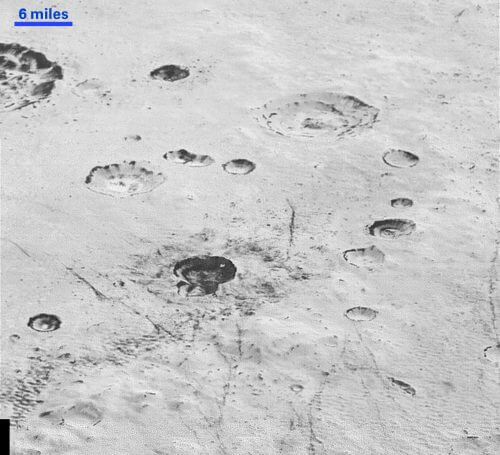
In total, more than 1000 craters were found on the photographed side. Most likely their origin is from the Kuiper Belt (8). Some of the craters are larger than 288 km in diameter. Some of the craters have weathered and there are some that have ice on their bottoms and sides. Another region, named Cthulhu Regio, is full of craters. Sputnik Planum has no evidence of impact craters. It is likely that this area has undergone weathering that is estimated to have continued for the past hundreds of millions of years. It is possible that these processes continue even today (46). In the crater named Organa there is a high concentration of ammonia, while in the nearby crater there is no ammonia at all. Where the ammonia came to that crater is not clear. According to one hypothesis, the same impactor that created this crater hit an area rich in ammonia ice or that the impactor itself had a lot of this material. What is interesting is that ammonia is an antifreeze in ice worlds. If the source of ammonia is from the interior of Pluto, then it can reach the surface following cryovolcanism (47). There is only one crater in Wright Mons, which means, according to the researchers' assessment, that the surface was recently formed (48). Vega terra has craters with halos around them. The largest crater has a diameter of 50 km. A connection was found between the halo of the craters and the explosiveness of the methane ice. At the bottom of the craters and around them there is water ice. In this area, the methane ice is found on the sides and rim of the craters and is light. The reason for this is unknown. This phenomenon has not been observed elsewhere on Pluto (49).
Mountains
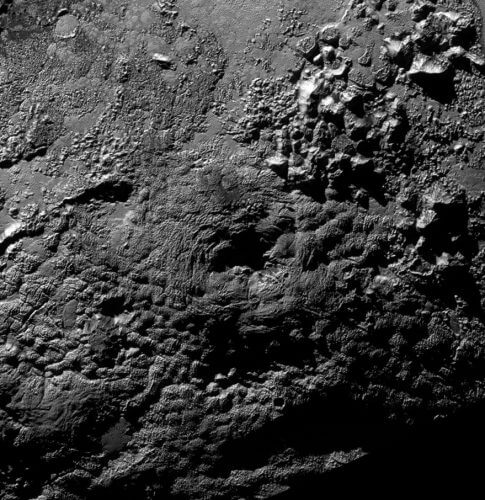
In the first photographs, they noticed icebergs rising to a height of 4-3 km. It is estimated that the base "rocks" of these mountains are made of water ice (50). A mountain range was found, albeit lower, at the edge of the heart shape that was given the name Tombough Regio. The height of the ridge is 1.5 - 1 km. This ridge was named Norgy Mons (51). A mountain located in Spuntik Planum was named Wright Mons and is 160 km wide and 4 km high. At its summit there is a depression 56 km long with a distinct rocky texture different from its surroundings. It has a concentric crack / this mountain like another mountain Piccard Mons which is more than 4 km high was probably formed by volcanic activity of cryovolcanism. These two mountain peaks, which are 160 km wide and 4 km high, have depressions in their center, which indicates that they are volcanoes. If Wright Mons and Piccard Mons are indeed volcanoes, what is emitted from them is a mixture of water ice, nitrogen, ammonia or methane (52). The Regio Cthulhu region extends along half of the equator, its length is 3000 km and its width is 750 km. It is dark and there are mountains whose summits are covered with snow. The surface of the Regio Cthulhu region is light. Probably because of the tholin layer that covers them (53). Photographs from an area named Tartarus Dorsa showed a ridge of blue-gray hills with reddish material between them. A soil was found there whose texture looked like a snake's skin and it was given the name snakeskin, valleys (chasms) crossing ancient soil and glacial flow. The length of this area is hundreds of kilometers (54).
For the first part of the series
For the third part of the series
Sources
25.. Jason Major – “Cloudgate: Rumors spread of Nitrogen clouds on Pluto"7.3.2016
26. Stephen Clark- “Haunting sunset vista shows foggy hazes on Pluto"17.9.2015
27. Iran Klotz – “Pluto may host an ocean"21.12.2010
28. Irene Klotz –“Pluto probably has an ocean under its surface"17.3.2016
29. 'Flowing Nitrogen ice glaciers seen in Pluto"24.7.2015
30. 'New Pluto images from New Horizons: It's complicated"13.9.2015
31. Alex Parker - "Pluto at twilight" 29.9.2015
32. 'Charon Pluto's big moon Charon reveals a colorful and violent history"2.10.2015
33. PIA20362 : Pluto's haze in band of blue
34. 'Pluto haze varies in brightness "19.4.2016
35. 'Hubble catches Pluto changing with the years"5.2.2010
36. Stephen Clark – “Surface marking shows up in newest Pluto imagery"29.4.2019
37. George Dvorsky – “New Horizons has detected Methane on Pluto"7.1.2015
38. 'Houston we have geology"11.7.2015
39. Richard Gray – “Now a mysterious bright spot seen on Pluto: New Horizon's space probe captures white patch close to dwarf planet's north pole"30.6.2015
40. 'Last portrait of Pluto's puzzling spots"12.7.2015
41. William Harwood – “Initial Pluto flyby science results published"16.10.2015
42. Stephen Clark – “Weird mountains on Pluto may be ice volcanoes"9.11.2015
43. William Harwood – “Pluto's floating intriguing structures fascinate scientists"5.1.2016
44. 'X marks a curious corner on Pluto's icy plains"10.1.2016
45. Stephen Clark – “Scientist reveals latest Pluto close ups"10.9.2015
46. William Harwood –“Initial Pluto flyby results published"16.10.2015
47. Stephen Clark- “A crescent Pluto shines like a jewel in the Kuiper belt” 29.10.2015
48. 'Possible ice volcano on Pluto has the Wright stuff"15.1.2016
49. 'Pluto 'halo' craters"22.4.2016
50. Kerry Sheridan – “Icy mountain ranges seen on Pluto after NASA flyby"15.07.2015
51. 'New Horizon finds second mountain range in Pluto's heart"22.7.2015
52. Bob King – “Clouds seen on Pluto for the first time"5.3.2016
53. 'Methane snow on Pluto's peaks"4.3.2016
54. Stephen Clark – “Secrets behind Pluto's pastels far from being answered"24.9.2015
